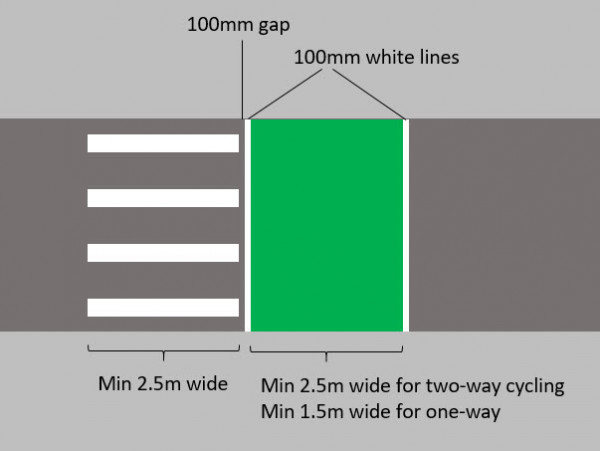An unsignalised crossing is a facility where provision is made for cyclists and/or pedestrians to cross the road and priority is not given without the use of traffic signals. The range of facilities available in increasing order of control and protection for active road users includes:
![]() Vehicle drivers must give way to pedestrians at zebra crossings Land Transport (Road User) Rule, Clause 10.1)(external link). As cycles are not specifically mentioned by the rule and do not fall under the definition of ‘pedestrian’, it follows that riding across a zebra crossing does not result in drivers having to give way to cyclists.
Vehicle drivers must give way to pedestrians at zebra crossings Land Transport (Road User) Rule, Clause 10.1)(external link). As cycles are not specifically mentioned by the rule and do not fall under the definition of ‘pedestrian’, it follows that riding across a zebra crossing does not result in drivers having to give way to cyclists.
Cycle precedence over a roadway at a crossing is achieved by placing give-way controls against the roadway approaches (Land Transport (Traffic Control Devices) Rule Clause 11.4(5)(external link)). A general information sign ‘watch for traffic’ is also provided for cyclists on the approach to the crossing. It is possible to have dual cycle/pedestrian crossings.
A dual cycle/pedestrian crossing is formed by the provision of a zebra crossing with an adjacent cycle crossing usually marked by green surfacing and give way controls for approaching traffic with a supplementary plate ‘to pedestrians and cyclists’. It should be noted that the green surfacing has no legal significance, and it is the give-way signs and markings that create the precedence.
Many of the design considerations for pedestrian crossings also apply to cyclists. However, cyclists may require longer storage space to accommodate the bicycle (particularly at median refuges). To accommodate a cargo bike, tandem or trailer bike, the storage space needs to be 2.5-3.0 metres long.
The TCD Manual Part 5 will provide designs, markings and signage requirements for each of the crossing types.
In the interim, Chapter 15 of the Pedestrian Planning and Design Guide provides useful design information. MOTSAM Part 2 Section 4.02 includes marking guidance for zebra crossings.
Motorist speed
If using a dual cycle and pedestrian crossing, motorists need to be travelling at an appropriate speed when approaching and travelling across a crossing point to reduce the likelihood and severity of a crash with a user.
Speeds should be below 30km/h and ideally below 20km/h. Vertical elements are the most effective in reducing speeds and it is recommended that a raised platform should be used at the crossing point with steep ramps to achieve the target vehicle speed. If the crossing is on a bus route, and ramps are flatter additional calming features should also be considered to achieve the target speed.
If existing speeds are high on the approaches to the crossing, additional treatments should be incorporated also. These may include speed cushions or humps in the approaching lanes.
Regulatory signs and markings
Signs are required to give precedence to people crossing the roadway. Drivers must be able to see give way controls, which are to be supplemented by a ‘to pedestrians and cyclists’ plate, on the approach to the crossing. These signs can be gated.
Road markings should be generally consistent with pedestrian crossing markings for limit lines and crosswalk lines. A give-way triangle is also required.
Lighting
Lighting is essential so that the crossing can continue to operate safely during the hours of darkness so drivers can see users on the crossing or approaching the crossing.
Raised crossing – platform height
The height of the raised platform not only determines the effectiveness of speed reduction by drivers, but it can also affect accessibility for users. A full height platform (top of kerb to top of kerb) improves accessibility for pedestrians, especially wheelchair users, but also for people cycling or scootering as it provides a continuous path of travel across the road without having to drop down then up again.
Cycle speeds
Cyclists should not be able to enter the crossing at high speed, so it is recommended that deflection is created on the approach to the crossing either through the alignment of the path, access control devices or careful placement of street furniture. These should look to slow cycle speeds but not create hazards for people on bicycles.
It is also advisable to incorporate a ‘Cyclists watch for traffic’ sign on the approach, as there is no legal onus on cyclists to check before riding onto a crossing.
Dimensions
Shorter crossing distances reduce exposure for users, and so the crossing distance should be minimised where possible, although carriageway widths should still consider on-road users travelling along the road corridor.

Dual cycle/zebra crossing markings. Note the white lines used to highlight the cycle crossing. (Image: Auckland Transport)
The width of the cycle crossing area, marked with green surface colour, should be able to both accommodate peak cycle demands, and to minimise conflict between two-way crossing movements. At a minimum the cycle crossing area should be at least 2 metres wide, but 3 metres or more is often preferred. Any adjacent zebra crossing should adhere to minimum width requirements (at least 2 metres wide).
Coloured surfacing
The carriageway crossing should use coloured surfacing. Tactile pavers must be installed in accordance with RTS 14 to meet slip resistant standards; this is of importance if cyclists are approaching from sharper turns or from acute angles.
It should be noted that the green surfacing has no legal significance, and it is the give-way signs and markings that create the precedence.